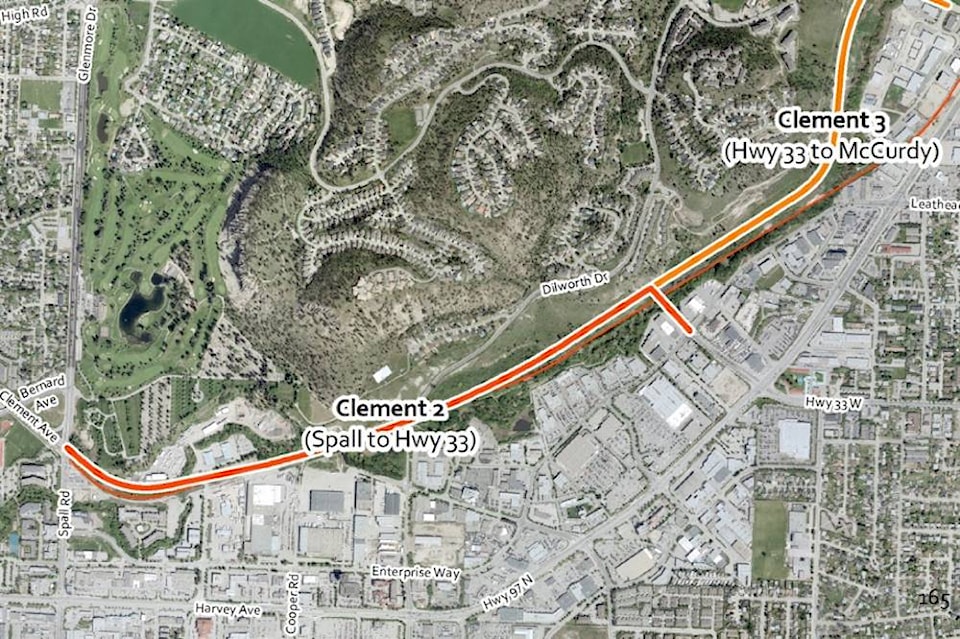A second bridge over Okanagan Lake and a freeway alternative along Kelowna’s north end are unlikely according to city planners and unnecessary according to some city councillors.
City staff described the project as “prohibitively expensive,” after an over-$300 million jump in price since initial plans in 2007. The project would now likely cost “well in excess” of $1 billion.
“In terms of cost-benefit analysis; it’s proven to be difficult,” said Rafael Villarreal, the city’s integrated transportation department manager, while presenting a report to council on Monday.
“To make sense, it has to be a full freeway or it’s not of enough benefit. It’s difficult to say the concept is dead, but the reality is, we don’t know when it’s going to happen. I’m not even sure if it’s within 20 or 25 years.”
READ MORE: Minster says Highway 97 study is on hold
READ MORE: Second bridge across Okanagan Lake ‘unlikely’ because of $1 billion price tag
The historic vision of the Highway 33 extension plan was coined as a Highway 97 alternative, connecting UBCO on the east end of the city to a second bridge over the lake to West Kelowna by a highspeed freeway, but that plan now looks doubtful due to inflated costs.
Instead, an incremental approach is being sought by city staff.
The revised plans indicate it may be more realistic to build an arterial roadway connecting Clement Avenue to McCurdy Road instead of the high-speed freeway with interchanges that was initially envisioned in the first plan. Clement Avenue currently ends at Spall Road.
The proposed road would run parallel to the Rail Trail, which was recently completed by the city. If the plan moves forward the city would have to relocate its bus facility.
The scope of work includes a four-lane connection between Spall Road and Highway 33, with at-grade intersections at Spall, Dilworth, and Enterprise. The most recent cost estimate for theis work is $57 million.
Councillors largely dismissed the second crossing but commended the staff’s work on seeking a less drastic approach.
“An incremental approach from Spall to Dilworth — Highway 33 if we’re lucky — would be a useful road that will help overall,” said Coun. Luke Stack.
“I like the incremental approach to moving this forward and I think we’re on the right path.”
Despite the fact that she hasn’t dismissed a second bridge for the future, Coun. Gail Given said she sees “great wisdom” in staff investigating the extension as an arterial roadway rather than a freeway.
“While we haven’t totally written off the second crossing, the evidence points in a different direction,” she said.
“(This plan) is going to provide the best benefit to our community in the shorter term.”
She did, however, ask staff to consider the potential future development in their land acquisitions.
“There’s nothing worse than having a highway corridor that’s constrained with a building immediately on either side and you have no options into the future. As we do our land acquisition, we should plan for a much broader corridor. One that would support transit into the future or that would support a freeway into the future.”
A “bridge to nowhere” is how Coun. Charlie Hodge described the second crossing.
“Building a second crossing in my mind makes no sense,” said Coun. Charlie Hodge.
Hodge expressed concerns about the environmental impact of the project, citing that the newly proposed plans cross two wetlands.
“This road goes right through wetlands. What does the Ministry of Environment have to say about that?” he asked.
Villarreal said the area between Spall and Highway 33 is a very complicated site from an environmental perspective.
“When the first designs were done in 2008, the regulation wasn’t as complicated as it is today,” he said.
“We are going to make sure that there is enough mitigation. The ministry is going to have to tell us what we need.
“That’s part of why this road is expensive. If we’re going to build it, we have to make sure we comply with all the environmental regulations.”
@michaelrdrguez
michael.rodriguez@kelownacapnews.com
Like us on Facebook and follow us on Twitter.
